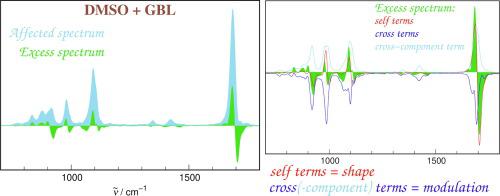Journal of Molecular Liquids ( IF 6 ) Pub Date : 2021-09-16 , DOI: 10.1016/j.molliq.2021.117544 Maciej Śmiechowski 1

|
Infrared (IR) spectroscopy is an invaluable tool in studying intermolecular interactions in solvent mixtures. The deviation of the IR spectrum of a mixture from the spectra of its pure components is a sensitive measure of the non-ideality of solutions and the modulation of intermolecular interactions introduced by mutual influence of the components. Excess IR spectroscopy, based on the established notion of excess thermodynamic functions, provides a well-defined picture of such deviation. On the other hand, the difference spectra method strives to obtain so-called affected spectra by numerically removing the bulk component contribution until the IR spectrum of the spectrally affected component is isolated. Although tremendously useful, excess IR spectroscopy remains poorly studied from a computational point of view. Based on ab initio molecular dynamics (AIMD) simulations, IR spectra of a dimethyl sulfoxide (DMSO)–-butyrolactone (GBL) liquid mixture are obtained here from first principles, without resorting to experimental input. Using dipolar decomposition techniques, the excess IR spectrum is further analyzed by rigorously separating the contributions from the modulation of the intra- and intermolecular parts of the spectra of both components and the mutual interaction spectrum. It is found that while the intramolecular part of excess IR spectrum is a good predictor of its overall shape, the intermolecular parts are crucial for elucidation of the band shifts and fine details of the IR spectrum of the mixture. Furthermore, the affected IR spectrum is obtained for both components by applying the spectral similarity method. The exact relationship between the affected and excess IR spectrum is derived and the latter is discovered as the predictor of the band shifts in the affected spectrum. Owing to a reduced cancellation effect of intermolecular contributions, the affected spectrum is a physically justified counterpart of the excess IR spectrum, providing a complementary view of the interactions in the mixture.
中文翻译:

过量红外光谱的分子水平解释
红外 (IR) 光谱是研究溶剂混合物中分子间相互作用的宝贵工具。混合物的 IR 光谱与其纯组分光谱的偏差是溶液非理想性和由组分的相互影响引入的分子间相互作用调制的敏感度量。过量 IR 光谱基于已建立的过量热力学函数的概念,提供了这种偏差的明确定义的图片。另一方面,差分光谱法力求通过在数值上去除体成分贡献,直到分离出光谱影响成分的红外光谱来获得所谓的受影响光谱。尽管非常有用,但从计算的角度来看,对过量红外光谱的研究仍然很少。-丁内酯 (GBL) 液体混合物是根据第一原理在这里获得的,无需借助实验输入。使用偶极分解技术,通过严格分离来自两个组分的光谱和相互作用光谱的分子内和分子间部分调制的贡献,进一步分析过量的红外光谱。发现虽然过量红外光谱的分子内部分是其整体形状的良好预测指标,但分子间部分对于阐明混合物的红外光谱的带移和精细细节至关重要。此外,通过应用光谱相似性方法获得两个组件的受影响的红外光谱。推导出受影响的和多余的 IR 光谱之间的确切关系,发现后者是受影响光谱中带移的预测因子。由于减少了分子间贡献的抵消效应,受影响的光谱是过量红外光谱的物理上合理的对应物,提供了混合物中相互作用的补充视图。

























 京公网安备 11010802027423号
京公网安备 11010802027423号